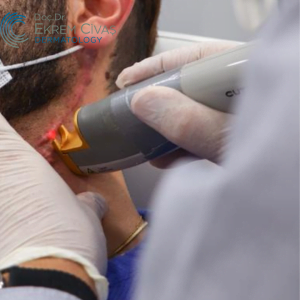
Keloid Scar – Scar Treatment
Keloid Scar Treatment, Keloid scar is a thick raised scar. It occurs wherever you have skin injuries. It usually appears on the shoulders, cheeks, earlobes, and chest. If you have a genetic predisposition, keloids form in more than one part of your body.
While keloid scars aren’t harmful to your health, they do bother you emotionally but keloid treatment gives good results. To solve this problem, you need to talk to a specialist doctor.
- Acne Scar Treatment ✓
- Scar Treatment ✓
What Are the Symptoms of Keloid?
If your scar occurs anywhere on your skin, get thick and grows after weeks or months, this is a keloid scar that we do not want. It’s symptoms are:
- Protruding, rough, hairless, irregular scar
- A localized area of reddish, brown or purplish color depending on your skin color
- Wound size that changes due to the cessation of keloid compared to the original wound
- Variety of soft, hard and rubber-like textures
- An itchy, unsightly skin scar
- Keloid scars, which are not serious health problems, may experience itching, discomfort, tenderness and possible irritation from rubbing on your clothes or otherwise.
Keloids do not threaten your life, but negatively affect your emotional state. You want to get rid of them, especially if they are in very large and visible places.
Why Does Keloid Occur?
Although it is not known exactly why they occur, they are thought to be a dysfunction in the wound healing process. Collagen (a protein found in the body) is important in wound healing. However, when overproduced, keloids can occur.
Any skin injury can also trigger keloid formation. For example; such as acne scars, ear piercing, burns, chickenpox, scratches, surgical incisions, vaccination sites…
Many people suffer from keloid scarring. Men and women have equal rates of developing keloids. But people with a darker shade are more prone to keloid.
If we list the risk factors for keloid scar formation;
- Those of Asian descent
- Those of Latin descent
- Those who are pregnant
- Under 30 years old
- If you are at risk of developing keloids, you should avoid body piercings, unnecessary surgeries and getting tattoos.
Keloid Diagnosis and Treatment
Dermatologists can usually tell if you have a keloid by looking at your skin. They may order a skin biopsy to lower the chance of cancer.
Keloids have different treatment methods. We can list as follows:
Wound care; It is the first treatment option for newly formed keloids. It is aimed to prevent the formation or growth of scars by applying pressure on the wound while it is healing. It is a difficult and long-term treatment.
corticosteroid cream; Used to relieve itching.
Drug injection; It is applied in small keloids. The thickness of the keloid can be reduced with cortisone or other steroids. Injected drugs can also cause side effects.
Freezing the wound; Small keloids are reduced or removed by freezing with cryotherapy. Treatments may need to be repeated. Side effects of cryotherapy can be skin discoloration, pain and swelling.
Laser therapy; We send a high beam of light to the keloid and the surrounding skin, reducing its size and fading its color. A better recovery is achieved when applied in additional treatments together with the laser.
Radiation treatments; After your dermatologist has surgically removed the keloid, radiation therapy can prevent the keloid from recurring. The size of the keloid is also reduced by radiation.
Ligature; treated with a surgical thread. If the keloid is suitable for threading, your dermatologist will try this method. The thread gradually cuts the keloid, allowing it to fall off.
Dermatologists research new treatment methods for keloids and choose the most suitable treatment methods for you with a holistic view. Studies on this subject are developing positively for patients. For example; Botulinum toxin type A (botox) for wound healing, stem cell therapy, experimental topical creams and injections, detection of genetic traces in keloid tissue. Such methods are promising.
Personal Care Advice for People with Keloids
- You should care for your wound as your doctor tells you to.
- Apply a corticosteroid cream.
- Apply silicone gel
- Protect against re-injury
- Protect your skin from the sun
- The moment you notice keloid formation on your skin or if you have a keloid and want to get rid of it, what you need to do is to go to a doctor (dermatologist) who specializes in the treatment of skin diseases and diagnosis.
As Civaş Klinik Ankara, we can help you in this regard, you can call to make an appointment or get information.

